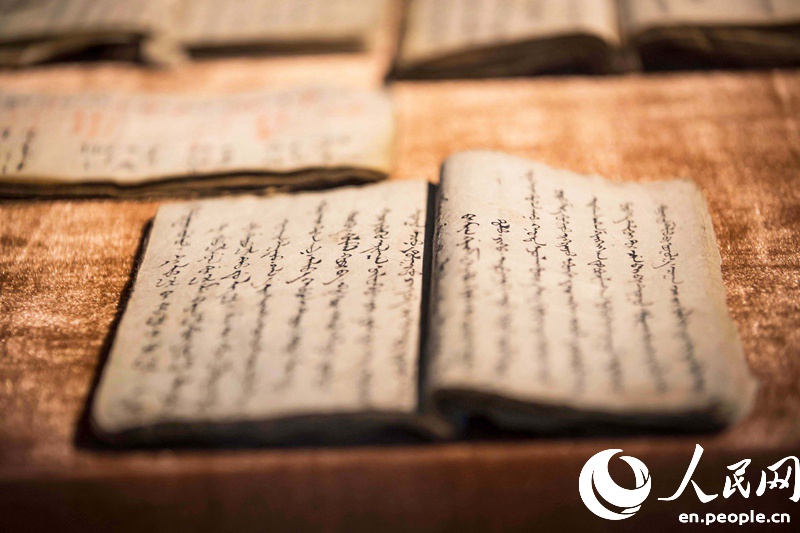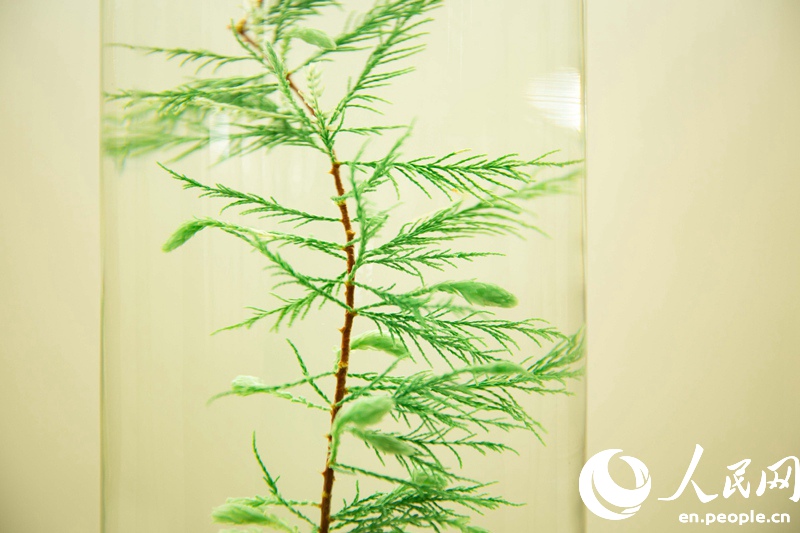


63-year-old Bayanmandula is one of China's first university students to major in TMM. [Photo by Tanja Herko]
It is already 9 p.m. In a dim lab at the Inner Mongolia University for Nationalities (IMUN), 63-year-old Bayanmandula and his students are still browsing ancient Mongolian medical records, using modern technology to analyze the efficacy of traditional herbs.
"According to historical records, there are thousands of traditional Mongolian medicines (TMM), but only a few hundred are still in use today. With the help of modern medical theory and advanced technology, I hope to discover more secrets of TMM with my remaining years," said Bayanmandula.

Ancient records of TMM. [Photo by Tanja Herko]
Born into a Mongolian family, Bayanmandula started to grow a keen interest in TMM when he was a child. When China's national college entrance exam, the gaokao, resumed in 1977, Bayanmandula took the exam and was admitted to the Inner Mongolia Medical University, becoming one of China's first university students to major in TMM. Ever since, he has dedicated his life to traditional medical practices.
"Mongolian medicine has been developing for thousands of years. It is a unique and precious resource in Inner Mongolia, which also mixes with traditional ethnic culture," said Bayanmandula.
After decades of hard work, Bayanmandula and his colleagues at IMUN have successfully conducted over 300 TMM research programs, earning 15 patents for medical innovation, while two traditional Mongolian medicines have been approved for clinical use. Every year, over 1,100 domestic and foreign students come to study TMM, many of whom go on to become professional TMM physicians.
"Generally considered to date back to the time of Genghis Khan (1162-1227, founder of the Mongol Empire), TMM is now stepping out of a relatively small circle of practitioners to reach more people," said Bayanmandula.
Combination of old and new

Herbs used by TMM. [Photo by Tanja Herko]
"Compared with Western medicine, TMM has relatively smaller doses, and mainly contains herbs and minerals. It is widely favored by the public for its close connection with nature, high quality and low price," said Bolong, a medical professor at IMUN.
For example, bone-setting in traditional Mongolian medicine is easy to practice and is not restricted by the environment. The technique at the Tongliao Traditional Mongolian Medicine Bone-setting Hospital has been listed on the national-level intangible cultural relic list.
"TMM is an empirical science, which lacks a theoretical framework and data. With modern technologies such as medical statistics and modern medical theories, TMM is now becoming more systematical and reliable," said Bolong.
"Nowadays, we are combining western medicine with TMM, hoping the latter can provide an alternative to treat diseases for which modern medicine has limited effect, such as chronic gynecological diseases and hemiplegia," said Bayanmandula.

Modern TMM lab at IMUN. [Photo by Tanja Herko]
The quickening development of TMM has also attracted international scholars and patients to come to Inner Mongolia. Established in 2012, the Inner Mongolia International Mongolian Medicine Hospital, which focuses on TMM treatment, has received many patients at home and aboard. The hospital has received about 30,000 patients from Mongolia, with more than 3,700 staying in the hospital for treatment. In 2016, the Affiliated Hospital of Inner Mongolia University for Nationalities worked with a college in Mongolia to establish a branch in Ulan Bator. This one branch receives more than 1,000 patients from Mongolia every year.
"TMM and modern medicine are complementary to each other. I hope TMM can play a more important role in the future, introducing the wisdom of Mongolian people and their culture to the world," said Bayanmandula.

 Award-winning photos show poverty reduction achievements in NE China's Jilin province
Award-winning photos show poverty reduction achievements in NE China's Jilin province People dance to greet advent of New Year in Ameiqituo Town, Guizhou
People dance to greet advent of New Year in Ameiqituo Town, Guizhou Fire brigade in Shanghai holds group wedding
Fire brigade in Shanghai holds group wedding Tourists enjoy ice sculptures in Datan Town, north China
Tourists enjoy ice sculptures in Datan Town, north China Sunset scenery of Dayan Pagoda in Xi'an
Sunset scenery of Dayan Pagoda in Xi'an Tourists have fun at scenic spot in Nanlong Town, NW China
Tourists have fun at scenic spot in Nanlong Town, NW China Harbin attracts tourists by making best use of ice in winter
Harbin attracts tourists by making best use of ice in winter In pics: FIS Alpine Ski Women's World Cup Slalom
In pics: FIS Alpine Ski Women's World Cup Slalom Black-necked cranes rest at reservoir in Lhunzhub County, Lhasa
Black-necked cranes rest at reservoir in Lhunzhub County, Lhasa China's FAST telescope will be available to foreign scientists in April
China's FAST telescope will be available to foreign scientists in April